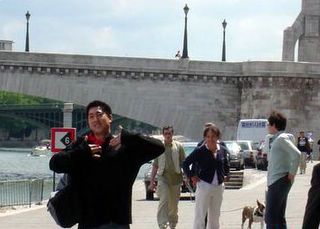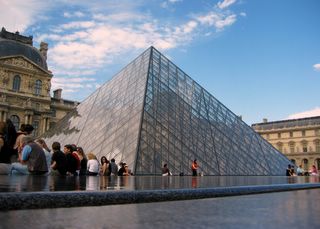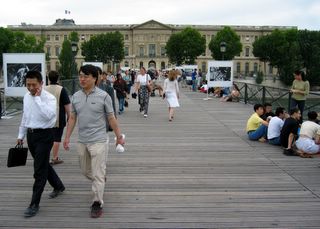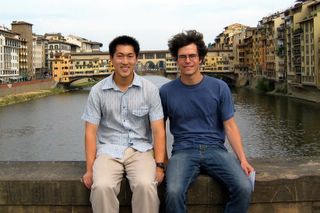Wednesday, June 30, 2004
Epilogue
There you have it: four countries and six cities in twenty days. Now that our tour in words and pictures has ended, we return to the question posed at the beginning. What is big in Europe?
For me, the answer was not the stuff of movies. Going buck wild wasn't big, nor was meeting the love of my life on a train, and "finding myself" certainly wasn't either. Instead, the answer came down to five S's:
Slenderness
I've said it once and I'll say it again — Europeans are skinny! It's not a secret how they get this way; in fact, it's quite trite. Their formula is exercising more and eating less. For exercise, Europeans don't go to the gym but simply spend a lot of time walking as part of their daily routine. They eat less because their food, from restaurant meals to pre-packaged snacks, is served in smaller portions.
Believe me, this simple combination works. During my trip, I ate much less than usual, and I spent at least half of each day on my feet. Net result: I lost twelve pounds! (Now that I'm back home, it's been a battle to keep the weight off.)
Sidewalks
Life in Europe happens on sidewalks, in cafés and in plazas. It didn't matter if it was during the week or the weekend, or what time of day it was — these places were always jam-packed. Whether it was chatting with a friend on the street, sitting down with a book or newspaper, or making small talk with a grocery clerk, the locals that I encountered liked to savor the moment. Sure, our longer work hours do result in greater prosperity (in real terms), but if you don't have time to enjoy life, is the extra money really worth it?
Now that I'm back home, I miss the busy sidewalks and people watching from a café or terrace bar. In the suburbs of the San Francisco Bay Area, there are few establishments with sidewalk seating, which is a shame because the climate there is perfect for them. Then again, there isn't much to see there besides cars and drive-thru fast food joints.
Style
Europeans have a great sense of style. The key adjective is becoming; individuals know what suits them and tone it down or play it up accordingly. They seldom err and end up looking trashy (except perhaps in southern Italy).
On this trip, I constantly noticed fashion differences between Europeans and Americans. The European was the one walking down the street in a smart-looking suit or a sexy, but not revealing, dress. The American was the one slouching with her flabby belly showing through her too-tight shirt.
Smoking
The vast majority of locals that I saw have the tobacco habit. As in the States, the cost of cigarettes is exorbitant — thus I wonder if smoking has a luxurious cachet. Smoking in Europe is a public health crisis waiting to explode. But on the other hand, it sure keeps men and women thin.
Staring
This occurs between strangers with far greater frequency than in the States, especially in Paris and Barcelona. People there will make eye contact with you that lasts ten seconds or more until you pass them. In general, residents of these cities are less suspicious and less scary than in America, which makes eye contact between strangers more permissible. For my part, I got quite a few looks, probably more on the days that I wore a bright red T-shirt that read "Play" on the front. Of course, I didn't have the linguistic confidence, or the nerve, to talk to any of these folks, but I did witness at least one instance (on a Parisian bus) when two complete strangers started up a friendly conversation.
Note: I tried catching glances from beautiful women in Italy, but naturally they looked straight ahead.
Lastly
I enjoyed my time in Europe tremendously (obviously so, or else I would not have produced this travelogue). I would like to go back there next summer. I've heard Greece is worth a visit, and also the beaches of Croatia. Prague is a popular destination these days. Maybe even the Wild East — Russia. Well, now that I have one significant travel experience under my belt, I think I could go on a real adventure!
Tuesday, June 29, 2004
So long
In Engin's room (where I was staying), I spotted a picture of the French actress Virginie Ledoyen on the wall. I asked him about this beauty, and then soon our conversation steered, not unexpectedly, in the direction of the fairer sex. "Now that you have been in Europe for three weeks," Engin began, "do you like European girls more or American girls?" I answered, frankly, that on the one hand, European girls have a certain grace that most American women lack. But on the other hand, they are kind of intimidating, and Americans seem easier to talk to. "What do you think of Italian girls?" asked Engin. "Sexy" was my one-word answer. He agreed. Then he revealed that he used to date a girl from Florence. Surprised, and a little excited, I asked him what that was like. "It is not like being in a romance," Engin admitted. "Italian girls have a force. Being with with them is a struggle." From what I saw of Italian women, I could understand his point of view.
My flight was at noon, and so the time came for me to say goodbye. I thanked Engin for letting me bunk with him and for a small gift, a calendar of his homeland, Turkey. I thanked Abi for the tasty dinner she prepared on the night Tim and I returned. (There were many more little things that these exceptionally nice two did.) Tim walked me to the train station. The next month, we both knew, was going to be heavy with withdrawal symptoms; Tim had to write his thesis, and I had to go back to work. But I would not have had it any other way.
Monday, June 28, 2004
Denis, Garnier, Pompidou and Harmon
In the morning, Tim and I went to the Cathedral of Saint Denis, located north of the city. This cathedral is where ten centuries of French kings are laid to rest. Interestingly, their remains are now jumbled together in one tomb, because they were exhumed from their original tombs during the French Revolution and re-interred haphazardly outside church grounds.

Catheral of St. Denis: heads will roll
Tim had to leave for a while to help Abi move out of her apartment, so I continued sightseeing alone. My next stop was the Paris Opera House. It is extraordinary. Its interior is opulent — the architect, Charles Garnier, spared no expense to ornament it. The grand foyer, which overlooks the main entrance and grand staircase, had just been renovated, and it looked absolutely spectacular.
My only disappointment was that I could not enter the auditorium, for a rehearsal was in progress. I could, however, peek in through a window and catch a glimpse of it.
I left the opera house and took the Metro to the Pompidou Center, a cultural hall featuring an art museum and reference library. The building itself is the attraction, though. Its modern design contrasts interestingly with the surrounding 19th-century architecture. I really liked its color scheme and exposed infrastructure (pipes, ducts, etc.).
I met up with Tim again and we then toured the Left Bank. We walked past the Sorbonne and the Panthéon and ended up at the Luxembourg Gardens. The park was quite busy, especially — I thought — for a Monday afternoon. There was even a live performance by a jazz band.
That night Tim, Abi, her friend Julien and I went to the 10th arondissement, the district that contains the St. Martin Canal (featured in the movie Amèlie). We went to a couple of bars, including a tiny one that holds jazz concerts. We caught the tail end of a set by a talented pianist named Yaron Harmon. After it was over, the bar, packed to the rafters, gave him a lengthy ovation.
Sunday, June 27, 2004
I'm Louvre-in' it
Back in Tim's apartment on this Sunday morning, I had brunch with Tim, his girlfriend, Abi, and his roommate Engin. We conversed about the vagaries of the English language. (Abi and Engin each speak a little.)
I spent the rest of the day in the Louvre. This museum is gargantuan, impossible to cover in five visits, let alone one. I managed to see a fair amount of it, though.

I.M. Pei's pyramid at the Louvre
I focused on Northern European paintings from the 16th and 17th centuries, 19th-century French paintings and the lengthy corridor exhibiting Italian works. The Mona Lisa and Venus de Milo were zoos.
 |
 |
| Life imitates art | |

Don't bother trying to get close
I found a pleasant surprise, which was the large-format French painting rooms on the first floor. This gallery houses a number of works that are masterpieces in their own right, but without the throngs crowding around the museum's most famous works.
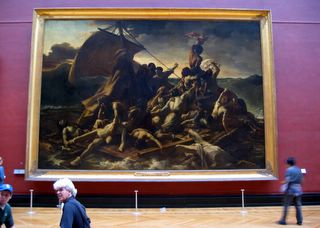 Raft of the Medusa, Gericault |
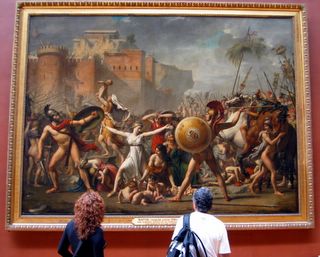 "And you thought we had fights" |
The Italian Corridor, too, has works by artists like Da Vinci and Caravaggio, but these are mostly ignored by the endless stream of visitors flowing straight down the end of the hall to the Mona Lisa.
My favorite pieces from this visit were an assortment of paintings by David, Delacroix and Gericault in the large-format gallery; The Valpinçon Bather, Ingres (Second Floor), Portrait of Baldassare Castigliano, Raphael (Italian Corridor); and frescoes [1, 2] by Botticelli (First Floor).
You can tell a city by its museum guards. In Rome and Florence, the guards are, bar none, well-dressed women. In Barcelona, they are young students. The guards in Paris wear conservative uniforms, but there is are equal numbers of men and women, and they are composed of many ethnicities. In San Francisco, museum guards are usually Filipino immigrants who can get the job rather easily and make just enough to send a small sum of money home.
After the Louvre closed, I explored the area around the museum. Nearby is an interesting bridge called Pont des Arts, a hangout for bohemians.

After ten days in Italy, the cool Parisian weather, and fashion, were refreshing
Back on the right bank is the Tuileries, where I went on my first day in Paris.

Summer breeze makes me feel fine
During my second weekend in the City of Lights, I couldn't help comparing it to the other cities I had just been to. With a huge population of immigrants from around the globe, Paris is certainly more cosmopolitan than any city in Italy, and it even rivals New York and San Francisco. For a city of its size, Paris is remarkably orderly. The tree-lined avenues are picturesque. The people are polite. The Metro is clean and efficient. Overall, Paris seemed to me a very livable city, although I would still rank it behind Barcelona in terms of getting around and use of English.
Saturday, June 26, 2004
One-hour Milan
We had about one hour to spend in Milan before we had to go to the airport. This was barely enough time to walk from the train station to the Duomo and back again. The Duomo is a cavernous cathedral (the world's third largest). I couldn't appreciate it fully, however, because the facade was underneath a web of scaffolding. We spent roughly fifteen minutes before heading back to the station. On the way, we passed La Scala, the famous opera house. This building, too, was under wraps. Still, I had a good impression of Milan. It felt more like Switzerland than Italy — the streets were wide and clean, the street traffic was light, there were a lot of green spaces, and the people were rather diverse (I saw blue-eyed blondes and Asians alike).
Died and went to heaven (almost)
We had a couple of hours to kill before catching a train to Milan, from where we would fly to Paris. We wanted to check out the Fortezza da Basso, thinking it was a castle or something. It turned out, though, to be a convention center, and that week it hosted Pitti Uomo, the most important men's fashion show in Europe. As we walked down the path to the main entrance, we were handed brochures and cheap giveaway bags by the most stunning women you'll ever see...doing this job. I wondered about the caliber of company reps manning the booths inside, but alas, we were bounced away before we could find out.
Milan may be the capital of Italian fashion, but Florence does not lag far behind in importance to the industry. The city's center is peppered with designer boutiques. Florentine men and women are fixated on their image to a degree that exceeds even Rome. Two days before, we saw a red carpet function in front of the Salvatore Ferragamo museum (that's right — a museum for the designer shoemaker). It seemed to be the kickoff event for the unveiling of the next season's fashions.

Party crashers who know how to dress for party-crashing
Florence is the most aloof city in Italy that we visited. There was a feeling of "look but don't touch": from the huge crowds who, pushed along by their tour guides, are barely able to cast a passing glance at the city's innumerable cultural treasures, to the shopping-bag-toting Florentines themselves, who seem so absorbed in looking cool that they wouldn't give a tourist the time of day. I doubt I have the patience to return to this city and try to peel back its skin.
Friday, June 25, 2004
Pork and beans
I spent this day visiting more churches and museums. Tim and I started with the Duomo, a cathedral in the center of town. Its green and pink exterior is unusual. Next we went across the street to the museum of the Duomo. At this worthwhile gallery, one can view sculptures and relics that once were housed within the cathedral but have since been moved away for safekeeping. My favorites were an unfinished Pietà by Michelangelo and Donatello's statue of Mary Magdalene.
 Duomo |
 Dome's interior |
 Pietà |
After our visit, we took a break for lunch at a sandwich shop. I had possibly the best sandwich of my life. It was a simple concoction, porchetta — or thin cuts of roast pork — on a roll, with no fixings nor condiments. Thus the pork had to carry the show, and boy, did it shine. The meat was heavily salted and seasoned, but that flavor was complemented by the fatty, juicy cut.
After lunch, I went to the Galleria dell'Accademia, the home of Michelangelo's David. This statue was well worth the 9.50 € admission. It's enormous, which is hard to realize from pictures. More than anything, I was impressed by its hands. They are disproportionately large and show off bulging veins. The Accademia holds many more works than David, though — far more than can be seen in one hour. The next time I am in Florence I will try to pay the Accademia another visit.
 |
 |
| My, what huge hands you have! | |
After that, Tim and I went to the Basilica di Santa Maria Novella, a church containing some impressive art, and ended the day's tour with a visit to the Boboli Gardens. This fairly large public space is good for a relaxing stroll, but falls short of Golden Gate Park in San Francisco for variety of sights, or for a fairer comparison, the estate of Versailles for grandeur. We wanted to stay there until dusk, but we were sent off early with a rude farewell. Techno music blared from an outdoor concert space for a God-knows-what kind of rehearsal.
We returned to town for dinner. For the last supper of our trip, we went to Trattoria da Zà-Zà, located near our hostel, and splurged by ordering all three courses of a proper Italian meal. It was late, by the time we finished, but anyway we decided to hang out and soak up the Florentine atmosphere one last time. We went to a couple of piazzas, but compared to Navona and Campo de Fiori in Rome, they were dead.
Thursday, June 24, 2004
Now museum, now you don't
This day was full of museums. Our first stop was the Brancacci Chapel, which contains frescoes that scholars say are the first artworks of the Renaissance. Seeing them was a pleasurable experience. The church wisely restricts access to about ten people per fifteen minutes, and we arrived early enough so that we did not have to wait very long to get in. Once we entered the chapel, I took my time to look closely at the frescoes (I had studied them in college), and even after the allotted time expired, the guard on duty let me stay as long as I wanted.
The rest of the museums we visited, unfortunately, were a fight against crowds. We circumvented them to some degree — for instance, we called the Uffizi gallery's ticket office the day before to reserve a timed entrance, and consequently we had to wait only ten minutes in line, as opposed to hours. But once inside the galleries, it was the rare room that did not have a long line to enter, or a huge crowd to squeeze through to get close to the artworks, or deafening noise. In one exhibit, I was in a room with three American college-aged kids who were standing in front of a 13th-century wooden door. I could see it coming — they put their clumsy hands on the fragile portal, oohing and aahing. A guard who saw this walked toward the offenders, and, in a tone reminiscent of an American giving an explanation to a hapless foreigner, waved them away. "These doors are very, very, very OLD. Please don't touch them!" Overall, the crowds, especially the younger tourists, were exasperating. (But man, were there some cuties!)
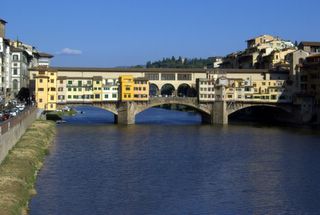 |
 |
| Ponte Vecchio | |
After the Brancacci Chapel, we crossed the river to the Uffizi. Its collection is highly focused on Florentine art from the Renaissance and the periods just before and after. The most famous works on display are a pair of Botticelli paintings, Birth of Venus and Primavera. The visit to the Uffizi was surprisingly manageable; we were able to see almost every room in roughly four hours. I must add that quite a few rooms were closed, which upset me because I had to pay 12.50 € ($15) admission.

Ponte Vecchio and Vasari Corridor of Uffizi
From there, we stopped at a café that happened to be on the route of a parade. June 24 is St. John's Feast day, an important holiday in Florence. The celebration includes a parade of local dignitaries, dressed in medieval costumes, a soccer match, and to top it off, a fireworks extravaganza.
In the evening, we bought a bottle of Chianti and a jar of olives, went back to our hostel and relaxed. (This hostel, compared to the one in Naples, was a Costco: ten times as many beds, a cafeteria, big screen TV and Internet access!) We capped the night by watching a thrilling Euro 2004 match between England and Portugal that featured two overtime goals and ended on penalty kicks.
Wednesday, June 23, 2004
Thor Heyerdahl was a tour operator?
Arriving in Florence in the afternoon, we first got acquainted with the city not by walking through it, but away from it, to hills across the river that afford a panoramic view. Our hour-long walk took us past some gated estates, easily worth fortunes. This place reminded me of exclusive quasi-rural communities in the Bay Area like Hillsborough or Palo Alto, but here, being only ten minutes away from the city center, it was even more impressive.

Street in Oltrarno, across the Arno River
We got good views from the Church of San Miniato and, of all places, a parking lot named Piazzale Michelangelo. At the latter, we encountered a tour group of twenty-somethings from America. They were dressed like they were going clubbing, even though it was not yet sunset. Curious, I asked one of them what all this was; she pointed to a tour bus tattooed with the name WWW.CONTIKI.COM. Con Tiki, it turns out, is a tour company specializing in vacation packages for young people, primarily singles. Sure enough, after the Con Tikists took their group photo, the girl that I spoke to walked back to the bus with some guy and let him put his arm around her. Con Tiki seems like a good bet for people who have money to spend, want new experiences, but at the same time would rather avoid surprises.
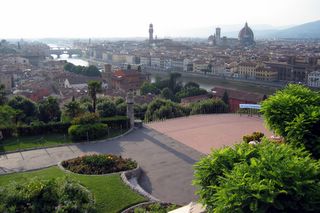 |
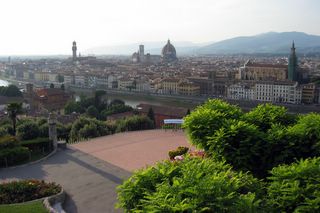 |
| From left: Ponte Vecchio, Campanile, Duomo, Basilica di Santa Croce |
I thought the crowds in Rome were bad, but I would take those in a heartbeat compared to what I had to deal with in Florence. Florence is tiny, and yet there were more visitors there than any other place on the trip. The result was that, no matter where I went, I met mobs of tourists. A good example is the restaurant Tim and I patronized that night. Called La Casalinga, it was recommended in the 2003 Let's Go guide for its authentic Tuscan cuisine, and since it was located on the opposite side of the river from the city center, it seemed that it could be an undiscovered secret. How naïve I was — it turned out that every table was full, and I heard Italian spoken at only one of them. For this reason, likely, La Casalinga was removed from the 2004 guide.
The food in Florence wasn't, in my opinion, quite as good as in Rome, but it was certainly pricier. Gelaterias are ubiquitous. I tried a gelato — it was creamy, more like American ice cream than the gelatos in Naples (whose consistency resembles packed ice).
